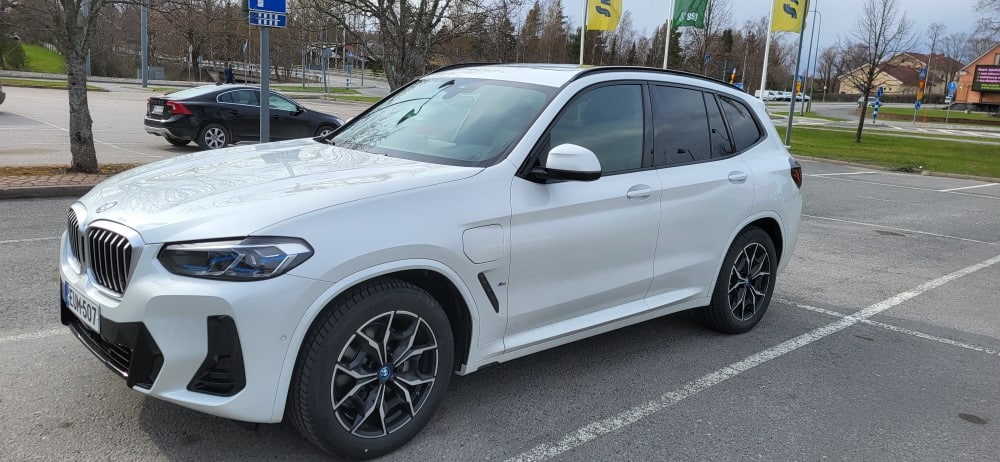Autotoday test drove the 2022 BMW X3 30e hybrid. The car has just landed in Finland by ship at the end of April. The mileage of the car was 29 km before the test drive started.
The BMW X3 model history dates back to 2003, when BMW launched the X3 (E83) four-wheel drive SUV. The X3 is now in its third generation. The second generation was launched in 2010 (F25) and the latest update in 2017 (G01).
The BMW X3’s appearance has received significant annual facelifts during its evolution. The latest refresh was implemented for the 2021-2022 model refresh. With the car reaching a respectable two decades of age, the car can already be called a legend.

The X3 and its big brother, the X5, have been perhaps the most significant trendsetters in the spread of SUV popularity. These BMWs are the stars of numerous American TV series and films. Perhaps this is a major reason why BMW’s X3 range is made in the USA.
The BMW X3 range offers traditional diesel (BMW X3 BMW M401) and petrol versions (BMW xDrive20i) and electric options, including an electric/petrol hybrid as well as the all-electric iX3i.
Electric or not
For buyers, the question of whether a hybrid car makes sense is always worth considering. When at best you can only drive 50 km on electric power, is that enough? However, a hybrid car is equipped with two different technologies, petrol and electric motors.

Driving on electric power with a range of a few tens of kilometres only allows for a short driving distance. If you want to drive a hybrid ecologically or, at today’s electricity prices, at a lower price than petrol, you need to have the car’s charging cable tightly connected to a wall socket. This is something everyone can consider before buying a hybrid car.
BMW is bringing new battery technology to cars for the 2025 model year, promising 30-40% extra capacity for driving distances, but still well below 100 km.
On the other hand, in the city, electricity is reasonably sufficient for shopping or an average commute. If the average daily driving distance is 50 km, and then there is a 6-10 hour charging phase ahead, hybrid electric driving is a viable solution.
At the same time, the petrol engine, alongside electricity, allows you to travel long distances effortlessly without the driving time constraints of a conventional electric car. In Finland, the driving range of a fully electric car is often in the 300-500 km range, which means longer stops and searching for charging points on longer journeys. This is certainly a significant factor when scoring the hybrid versus full electric options.
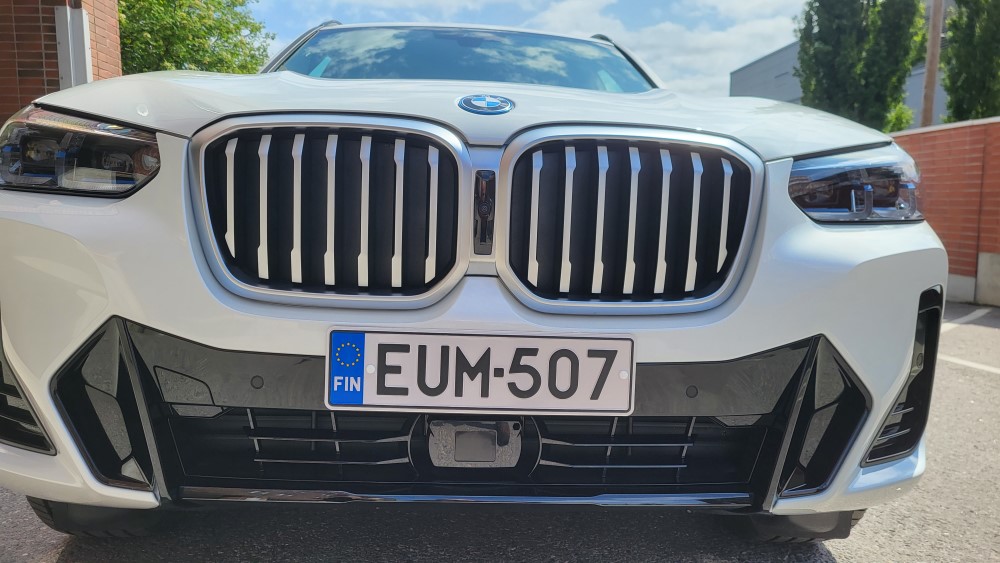
On the other hand, comparing hybrid to conventional internal combustion engine cars, it allows for other benefits than the sheer exhilaration of driving on electricity. Large batteries provide a “Webasto” replacement in winter.
Similarly, in summer, the car can be cooled down by electricity, even if it sits for hours in the sun, and this trick is beyond the reach of the “Webasto”.
In addition, the electric motor alongside the petrol engine is a more efficient source of power than the traditional turbocharger. A major advantage of the hybrid is its versatility. Perhaps ultimately, however, the biggest benefit of a hybrid for the buyer is the tax wedge.
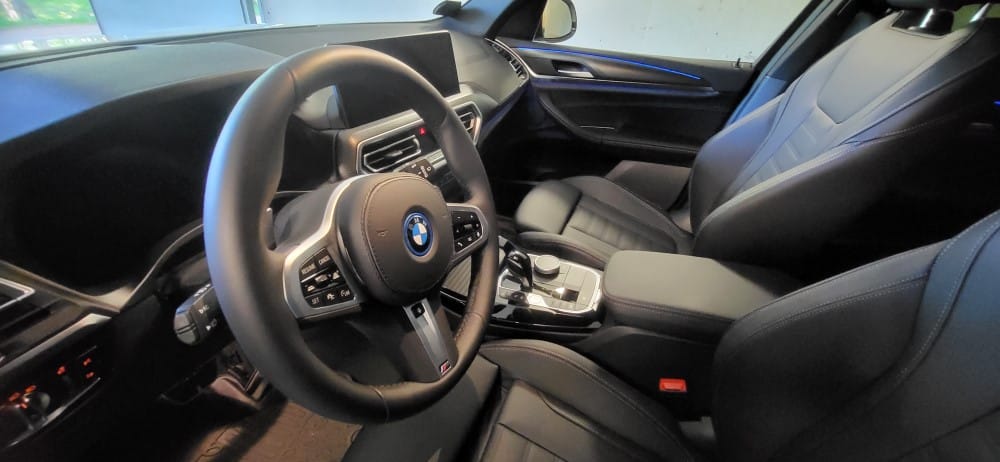
While similar luxury cars with fossil fuel engines often pay more than €10,000 in taxes, hybrids are mainly cosmetic. Reflecting on this, the question arises whether hybrids have ultimately been created more for greenwashing calculation tricks for tax optimisation than for other practical needs.
A new kind of pleasure
Whatever the reason for the existence of hybrid cars, however, driving a hybrid car is a new kind of pleasure.
The sense of power, the acceleration and the flexibility of two engine options for travelling is an ideal solution for long distances to Finland.
The BMW X3 is balanced in terms of driveability. The test car’s well-fitting leather seats with a wide range of adjustment features allow the driver to enjoy a comfortable, individually adjustable driving position. The adjustments are also easy to tweak while driving.

Perhaps best of all was the adjustable and adjustable headrest. I find this a challenge in many new car brands, as the limited range of motion of the headrest can start to strain the neck during longer drives.
In some makes, the head restraint is either fixed to the seat or has a very limited range of movement. Full marks for this BMW – no neck pain even after long journeys. On the other hand, the driving automatics, remember to harass the driver about taking breaks from driving moderately close.
Plenty of options
Our test car also came with a range of optional extras: Heated steering wheel, electrically retractable towing hook, panoramic sunroof, electrically adjustable front seats with memory function for the driver’s seat, galvanised body kits for the operating and control units, high beam assist, “Driving Assistant” package, BMW “Laserlight” headlights, Active Cruise Control “Stop & Go” functions, “Parking Assistant Plus” package, “Head-Up-Display”, BMW “Driving Recoder”, full leather upholstered sports seats, tinted rear windows, special metallic paintwork and winter tyres with aluminium rims.

The total price for the accessories package was EUR 14 240 excluding tax, and the entire test-driven car will leave the dealership at EUR 82 880 including EUR 2 822 car tax. This BMW X3 with this equipment was an eye-catching package that oozed driving comfort.
A sporty ride
The BMW X3 has retained its sporty feel in terms of driveability. The car is pleasingly responsive to steering and the suspension is firm enough in the German manner to give a sporty chassis feel on both tarmac and gravel roads.
While the car is certainly a compromise on a number of design details, the car has over 200 mm ground clearance, allowing it to travel ‘off-road’ in forest road conditions comfortably.
In off-road conditions, cameras and radars help the driver to detect any limits and obstacles on the road. The camera view is easily activated by pressing a button on the centre console
BMW electric car versions including the hybrid are significantly digitalised. The car has Wi-Fi network and hotspot available.
Mobile phone control
The My BMW app allows you to perform a number of management tasks on your mobile phone.
You can heat or cool the car, lock/unlock the doors, find the car in the car park and many other useful functions can be found in the app.
It also allows you to monitor the progress of the car’s electric charge, its technical status and to anticipate possible maintenance operations.
The remote functionalities will significantly increase user-friendliness, but at the same time the security of these numerous functionalities will also be considered.
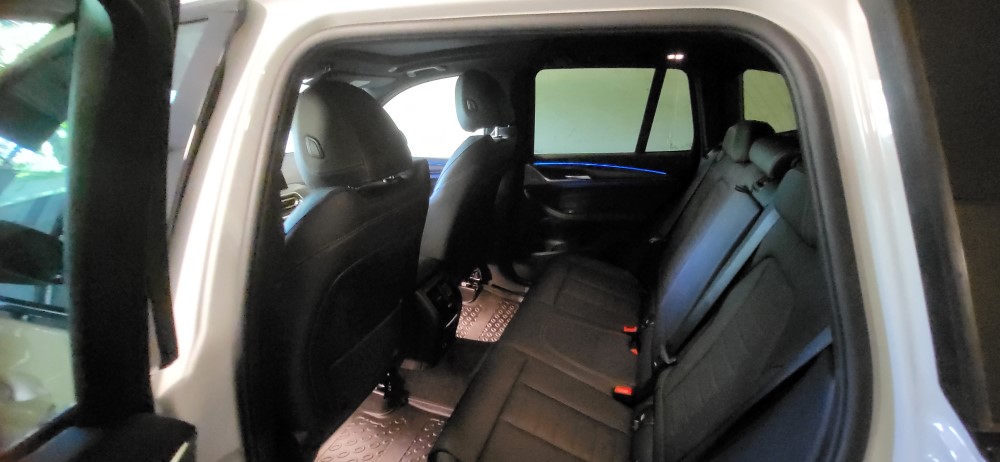
Here, the motorist is blinded into trusting completely the content provided by the car manufacturer, and believing that everything has been made safe by sufficient testing.
The driver is linked to the in-car functionality by encrypting the mobile phone and the key together. Once the key and phone are in the car, the driver is identified. The driver’s seat and mirrors are then automatically adjusted to the positions set by the driver.
The fact that the car still retains the controls of the original car is a welcome development. On the dashboard are more traditional keys that allow the control of various settings and driving functions without the need for on-screen apps.
This also makes it much easier to change the car’s settings and settings while driving, without having to look away from the road for an extended period of time.
In my opinion, too much concentration on a large digital screen can be a major risk factor while driving. It could be likened to the unfortunate, widespread driving habits seen too often in traffic, where drivers are typing while driving and looking at their mobile phones on the motorway. Too many serious accidents result from this nowadays, when the driver should have been looking closely at the road.
Three driving modes
The basic functionality of the car is adjusted according to three driving modes: [SPORT], [HYBRID] and [ELECTRIC]. Sport mode provides maximum power from both engines. In overtaking situations, for example, pressing the accelerator pedal to the floor will also give the car maximum power for ten seconds to smooth acceleration.

Similarly, the driver can select the [HYBRID] position for economical driving. In this case, both the electric motor and the combustion engine are used to optimum effect. If ecological mobility is selected, driving is only possible with electricity [ELECTRIC]. Electricity allows a driving distance of about 40-45 km under average driving conditions.
The centre console offers a choice of 360-degree camera visibility in the parking area or even on the driveway to facilitate visibility. A significant benefit is gained when entering a busy road in a city where buildings block visibility on the roadway. In such cases, the car’s front camera provides a “giraffe’s neck” of almost 1.5 metres to peer through the car’s nose at the road ahead, so that the driver does not have to squint neck-long to see if there might be movement on the carriageway or not.
An interior camera under the rearview mirror provides additional gesture controls for media and navigation guidance. These are perhaps more small “gimmicks” to show what the car can do with cameras, but still, can be useful solutions for everyday driving comfort. Perhaps the most useful thing here was to have navigation to a home address with just a small flick of the finger.
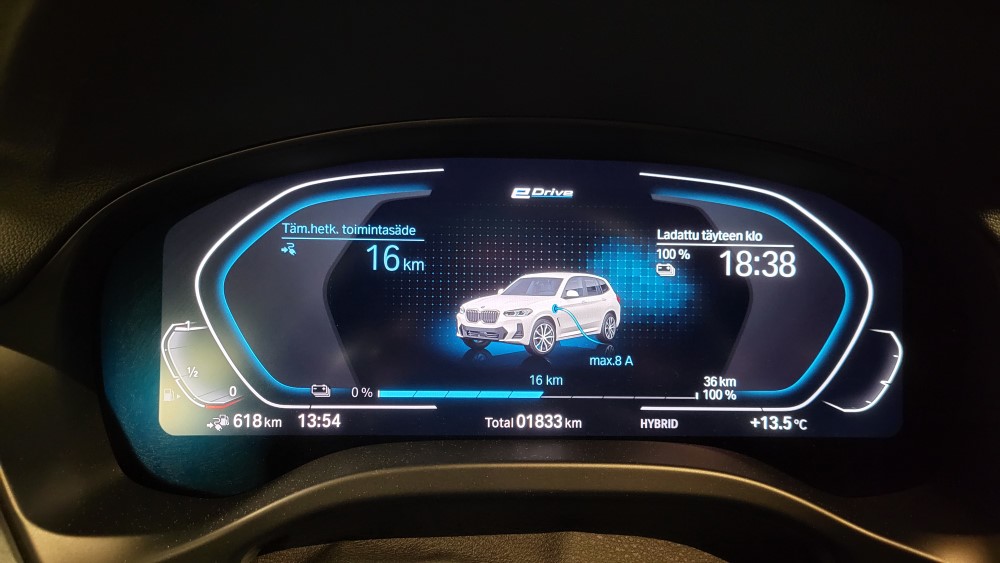
By choosing to equip your car with a “Head-Up-Display” option, the navigation software can be supplemented with a camera tripod. This is pure luxury! Camera tripod warnings are displayed with a warning message projected on the windscreen really smoothly.
This informs the driver of upcoming fixed automatic cameras on the road. This was definitely one of the best additional features during the test drive. The upgrade costs EUR 22 per year, and I think it will certainly pay for itself for most drivers.
Windows, sunroof and tailgate opened during the night
German automotive engineering expertise is strongly reflected in the overall design of the ‘Bemar’ X3. Many things are quite polished, and the fact that numerous original X3 enhancements are starting to show up after two decades. This is starting to be a fairly balanced and successful car in terms of basic features.
On the other hand, perhaps at the same time, it can be said that the German car engineer’s Digi skills still need updating in terms of competence, as well as further development in the future. The test drive revealed some “software bugs”. In the car’s own great “thinking”, wisdom to set up and operate, there was still room for improvement. Whether the fixes will come in the future as “firmware” updates remains to be seen.
Turning the car off and getting out of it proved to be one of the oddities. According to the settings made, the car should turn off all media systems and turn off the display screens, saying “goodbye” when the car is parked and the driver opens the door. But this was not the case.

Although the same procedures were performed with the same routines several times in a row, the result varied. Sometimes the radio would stay on and the screens would go blank, sometimes everything would turn off as set. Sometimes they only went off when the driver’s door was reopened, all turned off according to the manual settings.
One night the car had wisely decided to open all the windows, the sunroof and the tailgate by itself. They were wide open, waiting for me when I got to the car.
This was a very peculiar situation, which left me with a worrying doubt about the ‘security’ of the software. Was this due to a software bug? It could be that it was a remote action by BMW roadside assistance, perhaps they triggered a safety feature on the wrong car, a “panic alarm” and human error.
This is probably one of the actions typically done remotely to a car involved in an accident to help crash victims. It remains a mystery for the time being, which BMW service engineers will have to investigate and clarify further.
The test drive achieved a reasonable average fuel consumption of 4.0-4.1 l/100 km over a test distance of around 1000 km.
In practice, a fully charged battery was used alongside petrol. Some of the driving involved longer road trips, half of the total distance and half of the shorter urban driving. In the urban sections, the car was fully charged with appropriate charging cycles.
For normal everyday consumption, the electricity share will become much more important, especially in urban areas, but if the car is driven more long distances, the emphasis on internal combustion engines will become more pronounced. On the road, the combustion engine and the electric motor operated smoothly on the [HYBRID] settings, with both electricity and petrol consumed evenly.
In the test car, the panoramic sunroof worked well when it was conveniently above 20 degrees Celsius on hot days. The opening of the sunroof increased comfort, especially when driving in the city. But in the end, there are very few suitable days to use open roofs in the Finnish summer.
A little more space
The interior space of the BMW X3 has increased slightly from previous body versions, so that travelling in the back seat is clearly more comfortable than in older versions. Perhaps this is also one of the reasons why there is a reasonably high number of BMW X3 taxis on the road in Finland and other European cities. Before this body version, the BMW X3 was a rarity in taxi driving.
The hybrid’s boot has lost almost 10 centimetres in height, as the hybrid’s batteries are mainly located below the boot. This requires an extra effort to lift the groceries 10 centimetres higher than in the equivalent internal combustion engine version.
In addition, the empty space under the floor of the rear compartment and under the protective curtain remains quite cramped. If you’re transporting two hockey players to hockey practice, one of the hockey bags may be outside the boot, or stuffing it in could fill the entire boot up to the roof.
A pleasant driving experience
BMW offers a pleasant driving experience in this hybrid combination, with the right mix of the past and future of motoring harmoniously hand in hand. For many, this could be a good transition in motoring as we are in the monologue towards an increasingly automated future.
The active cruise control worked well in an optimised way when driving in different types of queue formation,” The “Head-Up-Display” made driving easier, including the ability to detect speed limits and camera poles with confidence.
Parking in a parking space was fully automatic, and the car remembered a 50-metre reversing manoeuvre from outside, and was able to repeat it by automatically returning to the starting point via the lanes, “futuristic everyday life”.
In addition, the adaptive laser lights make driving easier by eliminating the need to switch long headlights on/off, and the lights automatically adapt to the road. The efficiency of laser lights also brings new levels of safety, with visibility up to 500 metres far better than with conventional LED lights.
This will certainly bring a sense of safety to Finland’s dark autumn roads. The BMW X# hybrid is very well suited to Finnish conditions, when there is no time to stay on the side of the road waiting for the full electric car to charge.
It’s a pity that quality and equipment come at a price. The BMX X3 offers the luxury of riding when you add enough equipment to the basic model, but it also costs. Even for this test drive, you have to invest a considerable amount of money, even though the tax treatment is much milder in Finland.
BMW X3 xDrive30e G01 A Charged Edition M Sport
- Electric motor power: 80 kW (109 hp).
- Combustion engine power: 135 (184 hp)
- Engine maximum torque: 420 Nm.
- Transmission: 8-speed automatic
- Acceleration: 6.1 sec (0-100 km/h) and top speed 210 km/h (135 km/h with electric power)
- Manufacturer’s combined fuel consumption: 2-2.6l/100km (CO2 emissions 45-58g).
- Fuel tank capacity: 50 litres
- Electric range: 42-49 km
- Maximum charging power (AC): 3.75 kW.
- Tare weight: 2065 kg.
- Cargo space: 450 l.
- Traction: four-wheel drive
- Ground clearance: 204 mm
- Length: 4708 mm, width: 2138 mm (1891mm without mirrors) and height 1676 mm
- Towing capacity: 750 kg.
- Starting price: 62 381 euro
- Price for test drive: €82 880
Test drive and text by Juha Remes
